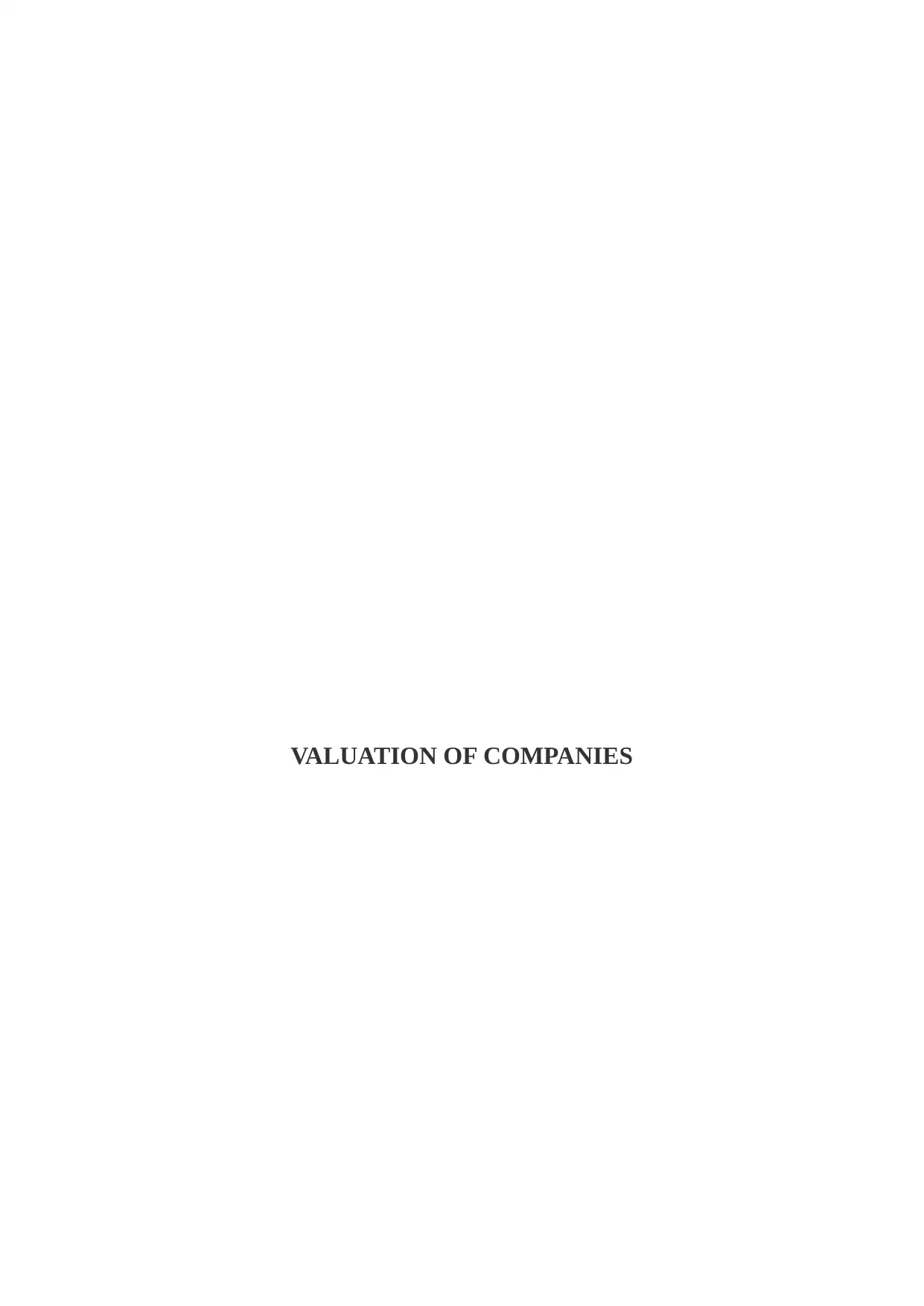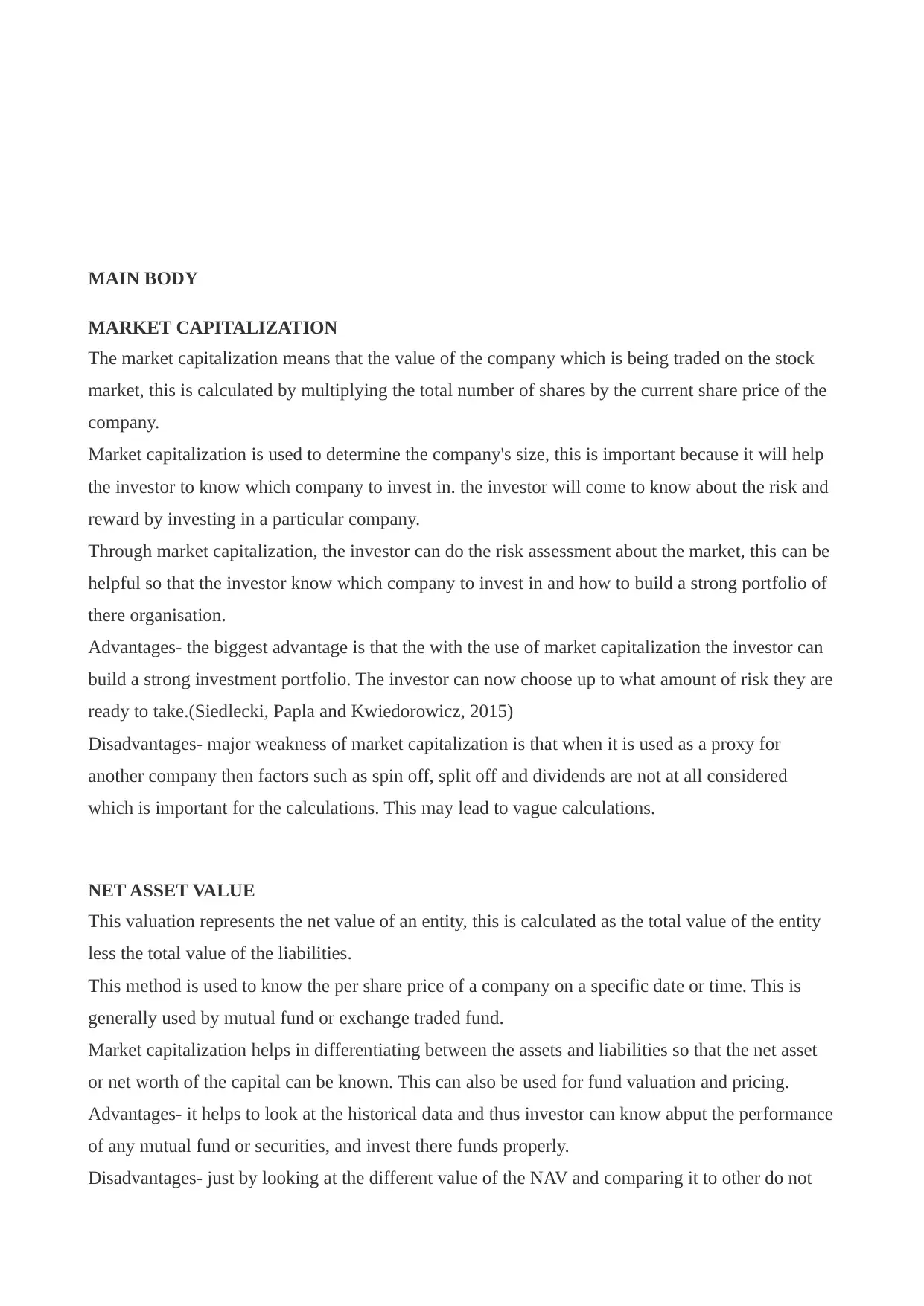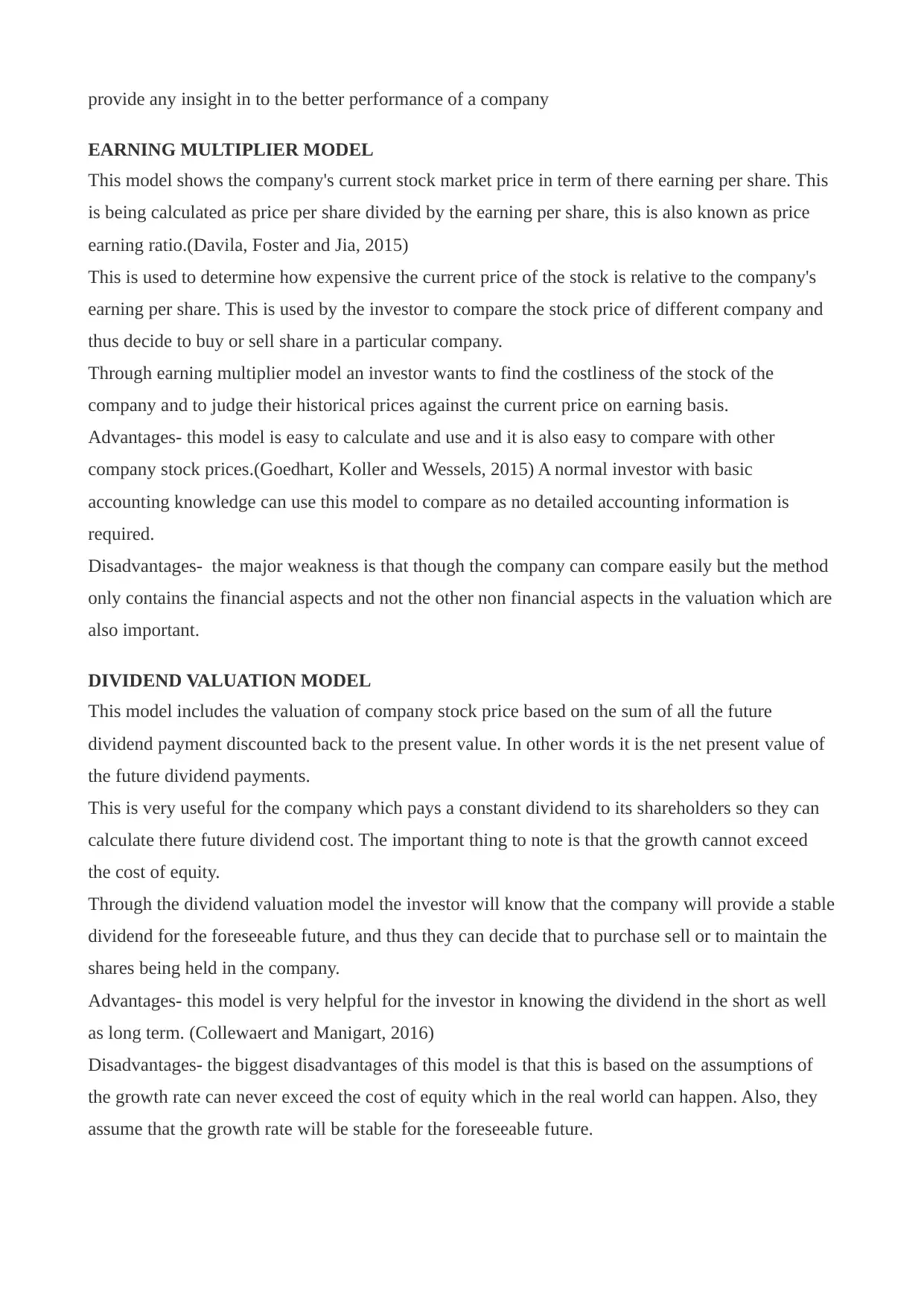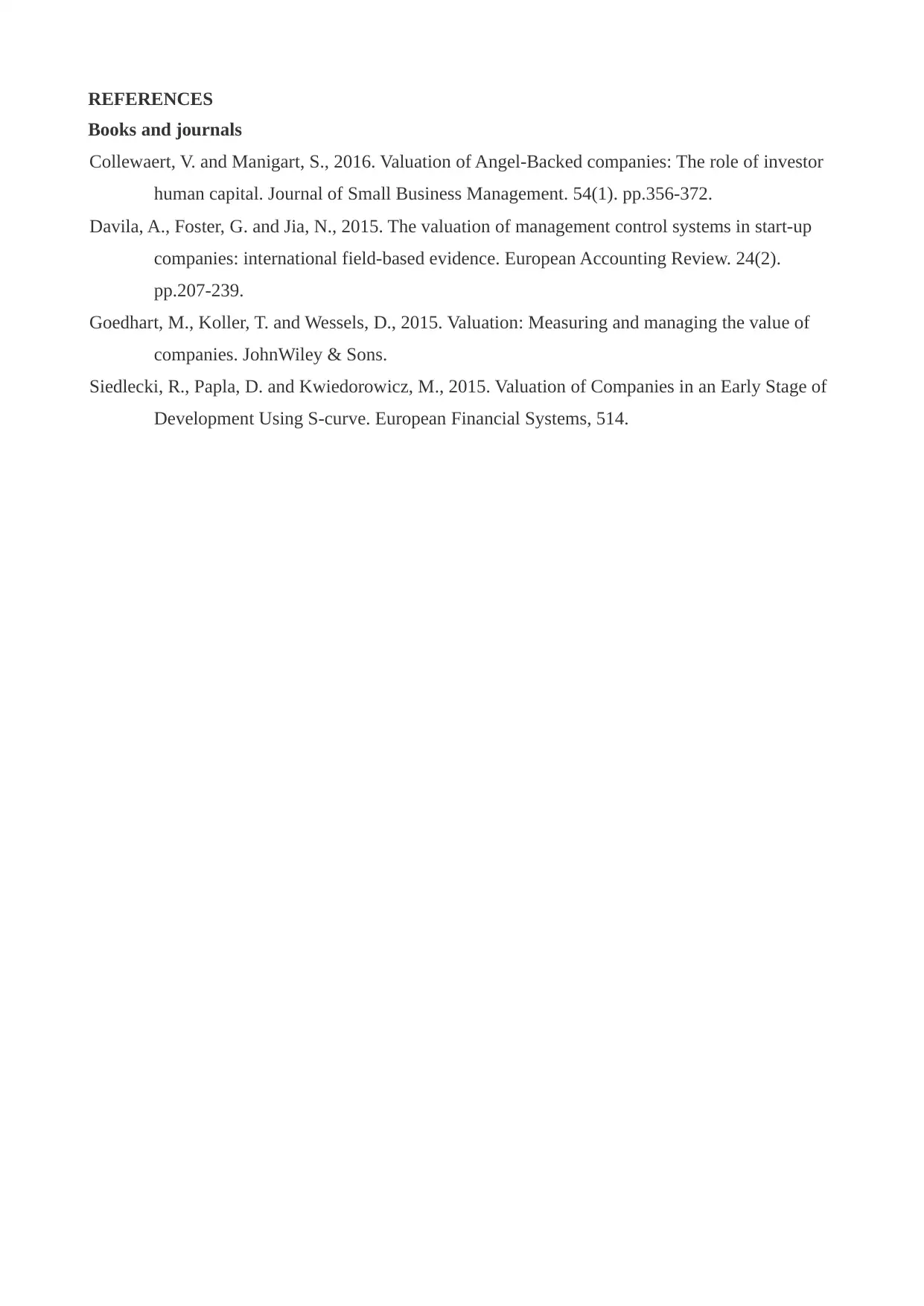Comprehensive Report on Company Valuation Techniques and Models
VerifiedAdded on 2023/01/18
|5
|979
|97
Report
AI Summary
This report provides an overview of company valuation techniques, including market capitalization, net asset value (NAV), the earning multiplier model, and the dividend valuation model. Market capitalization is explained as the total value of a company's shares, while NAV represents the net value of an entity based on its assets and liabilities. The earning multiplier model, also known as the price-earnings ratio, is discussed as a tool for assessing stock prices relative to earnings. Finally, the dividend valuation model is presented as a method for valuing stock based on the present value of future dividend payments. The report highlights the advantages and disadvantages of each method, providing insights into their practical applications and limitations. The report also includes references to relevant academic resources.

VALUATION OF COMPANIES
Paraphrase This Document
Need a fresh take? Get an instant paraphrase of this document with our AI Paraphraser

Table of Contents
MAIN BODY.......................................................................................................................................3
MARKET CAPITALIZATION.......................................................................................................3
NET ASSET VALUE.......................................................................................................................3
EARNING MULTIPLIER MODEL................................................................................................4
DIVIDEND VALUATION MODEL...............................................................................................4
REFERENCES.....................................................................................................................................5
MAIN BODY.......................................................................................................................................3
MARKET CAPITALIZATION.......................................................................................................3
NET ASSET VALUE.......................................................................................................................3
EARNING MULTIPLIER MODEL................................................................................................4
DIVIDEND VALUATION MODEL...............................................................................................4
REFERENCES.....................................................................................................................................5

MAIN BODY
MARKET CAPITALIZATION
The market capitalization means that the value of the company which is being traded on the stock
market, this is calculated by multiplying the total number of shares by the current share price of the
company.
Market capitalization is used to determine the company's size, this is important because it will help
the investor to know which company to invest in. the investor will come to know about the risk and
reward by investing in a particular company.
Through market capitalization, the investor can do the risk assessment about the market, this can be
helpful so that the investor know which company to invest in and how to build a strong portfolio of
there organisation.
Advantages- the biggest advantage is that the with the use of market capitalization the investor can
build a strong investment portfolio. The investor can now choose up to what amount of risk they are
ready to take.(Siedlecki, Papla and Kwiedorowicz, 2015)
Disadvantages- major weakness of market capitalization is that when it is used as a proxy for
another company then factors such as spin off, split off and dividends are not at all considered
which is important for the calculations. This may lead to vague calculations.
NET ASSET VALUE
This valuation represents the net value of an entity, this is calculated as the total value of the entity
less the total value of the liabilities.
This method is used to know the per share price of a company on a specific date or time. This is
generally used by mutual fund or exchange traded fund.
Market capitalization helps in differentiating between the assets and liabilities so that the net asset
or net worth of the capital can be known. This can also be used for fund valuation and pricing.
Advantages- it helps to look at the historical data and thus investor can know abput the performance
of any mutual fund or securities, and invest there funds properly.
Disadvantages- just by looking at the different value of the NAV and comparing it to other do not
MARKET CAPITALIZATION
The market capitalization means that the value of the company which is being traded on the stock
market, this is calculated by multiplying the total number of shares by the current share price of the
company.
Market capitalization is used to determine the company's size, this is important because it will help
the investor to know which company to invest in. the investor will come to know about the risk and
reward by investing in a particular company.
Through market capitalization, the investor can do the risk assessment about the market, this can be
helpful so that the investor know which company to invest in and how to build a strong portfolio of
there organisation.
Advantages- the biggest advantage is that the with the use of market capitalization the investor can
build a strong investment portfolio. The investor can now choose up to what amount of risk they are
ready to take.(Siedlecki, Papla and Kwiedorowicz, 2015)
Disadvantages- major weakness of market capitalization is that when it is used as a proxy for
another company then factors such as spin off, split off and dividends are not at all considered
which is important for the calculations. This may lead to vague calculations.
NET ASSET VALUE
This valuation represents the net value of an entity, this is calculated as the total value of the entity
less the total value of the liabilities.
This method is used to know the per share price of a company on a specific date or time. This is
generally used by mutual fund or exchange traded fund.
Market capitalization helps in differentiating between the assets and liabilities so that the net asset
or net worth of the capital can be known. This can also be used for fund valuation and pricing.
Advantages- it helps to look at the historical data and thus investor can know abput the performance
of any mutual fund or securities, and invest there funds properly.
Disadvantages- just by looking at the different value of the NAV and comparing it to other do not
⊘ This is a preview!⊘
Do you want full access?
Subscribe today to unlock all pages.

Trusted by 1+ million students worldwide

provide any insight in to the better performance of a company
EARNING MULTIPLIER MODEL
This model shows the company's current stock market price in term of there earning per share. This
is being calculated as price per share divided by the earning per share, this is also known as price
earning ratio.(Davila, Foster and Jia, 2015)
This is used to determine how expensive the current price of the stock is relative to the company's
earning per share. This is used by the investor to compare the stock price of different company and
thus decide to buy or sell share in a particular company.
Through earning multiplier model an investor wants to find the costliness of the stock of the
company and to judge their historical prices against the current price on earning basis.
Advantages- this model is easy to calculate and use and it is also easy to compare with other
company stock prices.(Goedhart, Koller and Wessels, 2015) A normal investor with basic
accounting knowledge can use this model to compare as no detailed accounting information is
required.
Disadvantages- the major weakness is that though the company can compare easily but the method
only contains the financial aspects and not the other non financial aspects in the valuation which are
also important.
DIVIDEND VALUATION MODEL
This model includes the valuation of company stock price based on the sum of all the future
dividend payment discounted back to the present value. In other words it is the net present value of
the future dividend payments.
This is very useful for the company which pays a constant dividend to its shareholders so they can
calculate there future dividend cost. The important thing to note is that the growth cannot exceed
the cost of equity.
Through the dividend valuation model the investor will know that the company will provide a stable
dividend for the foreseeable future, and thus they can decide that to purchase sell or to maintain the
shares being held in the company.
Advantages- this model is very helpful for the investor in knowing the dividend in the short as well
as long term. (Collewaert and Manigart, 2016)
Disadvantages- the biggest disadvantages of this model is that this is based on the assumptions of
the growth rate can never exceed the cost of equity which in the real world can happen. Also, they
assume that the growth rate will be stable for the foreseeable future.
EARNING MULTIPLIER MODEL
This model shows the company's current stock market price in term of there earning per share. This
is being calculated as price per share divided by the earning per share, this is also known as price
earning ratio.(Davila, Foster and Jia, 2015)
This is used to determine how expensive the current price of the stock is relative to the company's
earning per share. This is used by the investor to compare the stock price of different company and
thus decide to buy or sell share in a particular company.
Through earning multiplier model an investor wants to find the costliness of the stock of the
company and to judge their historical prices against the current price on earning basis.
Advantages- this model is easy to calculate and use and it is also easy to compare with other
company stock prices.(Goedhart, Koller and Wessels, 2015) A normal investor with basic
accounting knowledge can use this model to compare as no detailed accounting information is
required.
Disadvantages- the major weakness is that though the company can compare easily but the method
only contains the financial aspects and not the other non financial aspects in the valuation which are
also important.
DIVIDEND VALUATION MODEL
This model includes the valuation of company stock price based on the sum of all the future
dividend payment discounted back to the present value. In other words it is the net present value of
the future dividend payments.
This is very useful for the company which pays a constant dividend to its shareholders so they can
calculate there future dividend cost. The important thing to note is that the growth cannot exceed
the cost of equity.
Through the dividend valuation model the investor will know that the company will provide a stable
dividend for the foreseeable future, and thus they can decide that to purchase sell or to maintain the
shares being held in the company.
Advantages- this model is very helpful for the investor in knowing the dividend in the short as well
as long term. (Collewaert and Manigart, 2016)
Disadvantages- the biggest disadvantages of this model is that this is based on the assumptions of
the growth rate can never exceed the cost of equity which in the real world can happen. Also, they
assume that the growth rate will be stable for the foreseeable future.
Paraphrase This Document
Need a fresh take? Get an instant paraphrase of this document with our AI Paraphraser

REFERENCES
Books and journals
Collewaert, V. and Manigart, S., 2016. Valuation of Angel‐Backed companies: The role of investor
human capital. Journal of Small Business Management. 54(1). pp.356-372.
Davila, A., Foster, G. and Jia, N., 2015. The valuation of management control systems in start-up
companies: international field-based evidence. European Accounting Review. 24(2).
pp.207-239.
Goedhart, M., Koller, T. and Wessels, D., 2015. Valuation: Measuring and managing the value of
companies. JohnWiley & Sons.
Siedlecki, R., Papla, D. and Kwiedorowicz, M., 2015. Valuation of Companies in an Early Stage of
Development Using S-curve. European Financial Systems, 514.
Books and journals
Collewaert, V. and Manigart, S., 2016. Valuation of Angel‐Backed companies: The role of investor
human capital. Journal of Small Business Management. 54(1). pp.356-372.
Davila, A., Foster, G. and Jia, N., 2015. The valuation of management control systems in start-up
companies: international field-based evidence. European Accounting Review. 24(2).
pp.207-239.
Goedhart, M., Koller, T. and Wessels, D., 2015. Valuation: Measuring and managing the value of
companies. JohnWiley & Sons.
Siedlecki, R., Papla, D. and Kwiedorowicz, M., 2015. Valuation of Companies in an Early Stage of
Development Using S-curve. European Financial Systems, 514.
1 out of 5
Related Documents
Your All-in-One AI-Powered Toolkit for Academic Success.
+13062052269
info@desklib.com
Available 24*7 on WhatsApp / Email
![[object Object]](/_next/static/media/star-bottom.7253800d.svg)
Unlock your academic potential
Copyright © 2020–2025 A2Z Services. All Rights Reserved. Developed and managed by ZUCOL.





